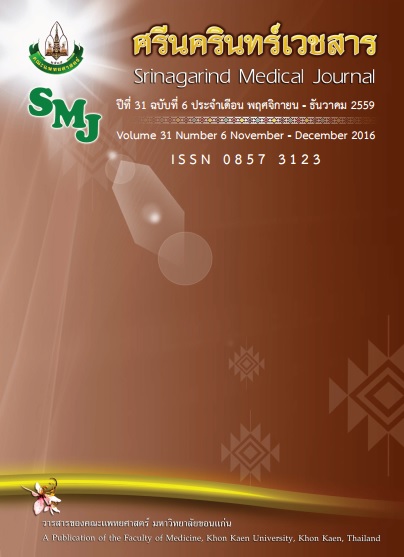A Comparison between Pilates Exercise and Balance Exercise on Balance Associated with Balance Confidence Among Elderly Community -Dwellers
Keywords:
Pilates exercise, Balance, Balance confidence, ออกกำลังกายพิลาทิส, การทรงตัว, ความมั่นใจในการทรงตัวAbstract
Background and Objective: Pilates exercise and balance exercise programs could increase balance strength and flexibility. However, the research is not enough evidence to support the effects of both exercise associated with balance confidence in the elderly. This study aimed to evaluate the effects of Pilates exercise and Balance exercise programs associated balance confidence in the elderly.
Method: Forty-five participants were randomly allocated into 3 groups, each of which had 12 exercise sessions over a period of 4 weeks. Group 1, Pilates exercise group; group 2, Balance exercise group; group 3, Control group was given general exercise program. Time Up and Go test (TUGT) and Modified-Activities-Specific Balance Confidence Scale (ABC) scale were measured before and after the intervention period.
Results: Groups 1 and group 2 showed a significant improvement in TUGT after 4 weeks of the program (p < 0.05), group 1 was significantly higher in the improvement of TUGT when compared with group 2. Therefore, (ABC) Scale was no significant statistic whitin groups. However, there were no significant differences in any parameters in group 3.
Conclusions: The both exercise programs can improve balance trend, increase balance confidence and may prevent falls among the elderly.
การเปรียบเทียบผลระหว่างโปรแกรมการออกกำลังกายแบบพิลาทิสและการออกกำลังกายแบบฝึกการทรงตัวที่เกี่ยวข้องกับความมั่นใจในการทรงตัวของผู้สูงอายุในชุมชน
หลักการและวัตถุประสงค์ การออกกำลังกายแบบพิลาทิส และแบบฝึกการทรงตัวเป็นการเพิ่มความสามารถในการทรงตัว ความแข็งแรง และความยืดหยุ่นของร่างกาย อย่างไรก็ตามยังขาดงานวิจัยที่สนับสนุนผลการออกกำลังกายดังกล่าว งานวิจัยนี้เพื่อศึกษาผลของการออกกำลังกายทั้ง 2 แบบ ที่สัมพันธ์กับความมั่นใจในการทรงตัวของผู้สูงอายุ
วิธีการศึกษา ผู้เข้าร่วมวิจัย 45 ราย สุ่มจับสลากเป็น 3 กลุ่ม 1. ออกกำลังกายแบบพิลาทิส 2. ออกกำลังกายแบบฝึกการทรงตัว ทั้งหมด 12 ครั้ง เป็นเวลา 4 สัปดาห์ และ 3. กลุ่มควบคุมได้รับคำแนะนำการออกกำลังกายทั่วไป ทุกกลุ่มประเมินโดย Time Up and Go Test (TUGT) และ Modified-Activities-Specific Balance Confidence Scale (ABC) scale ก่อนและหลังการศึกษา
ผลการศึกษา หลังจากโปรแกรม 4 สัปดาห์ พบว่าในกลุ่ม 1 และ 2 ค่า TUGT มีค่าแตกต่างกันอย่างมีนัยสำคัญทางสถิติ (p<0.05) ส่วนค่า (ABC) scale ไม่พบค่าแตกต่างกันอย่างมีนัยสำคัญทางสถิติ อย่างไรก็ตามไม่พบค่าแตกต่างกันอย่างมีนัยสำคัญทางสถิติของทุกตัวแปรเมื่อเปรียบเทียบทั้ง 3 กลุ่ม
สรุป การออกกำลังกายทั้ง 2 แบบ ทำให้เพิ่มความสามารถในการทรงตัวและมีแนวโน้มเพิ่มความมั่นใจในการทรงตัว ซึ่งอาจช่วยป้องกันการหกล้มในผู้สูงอายุได้




